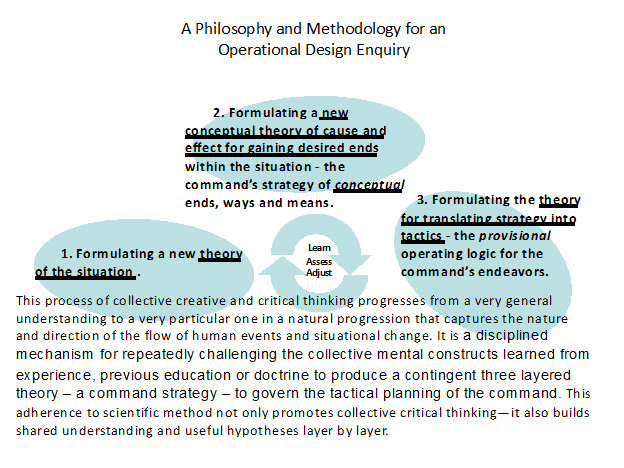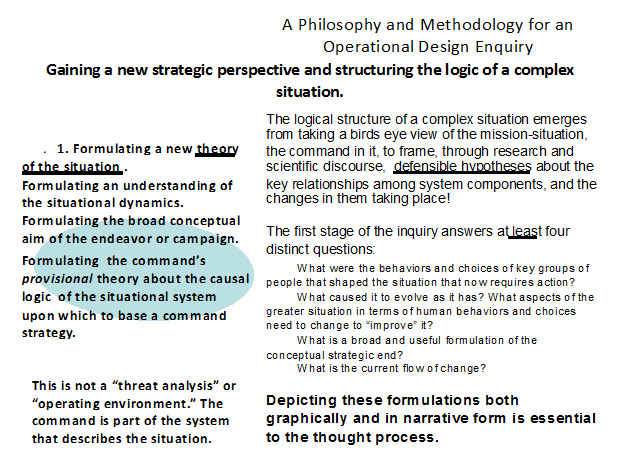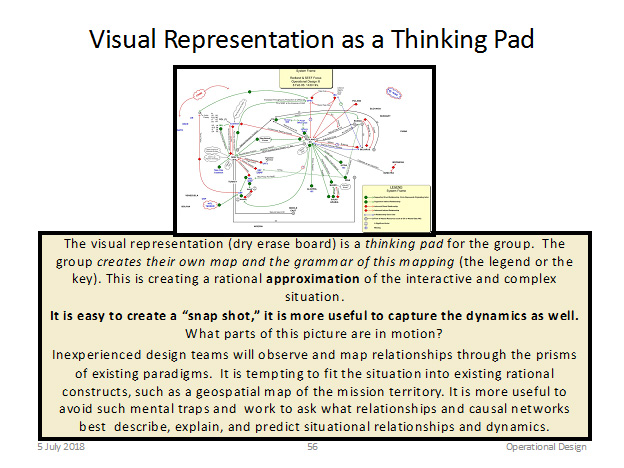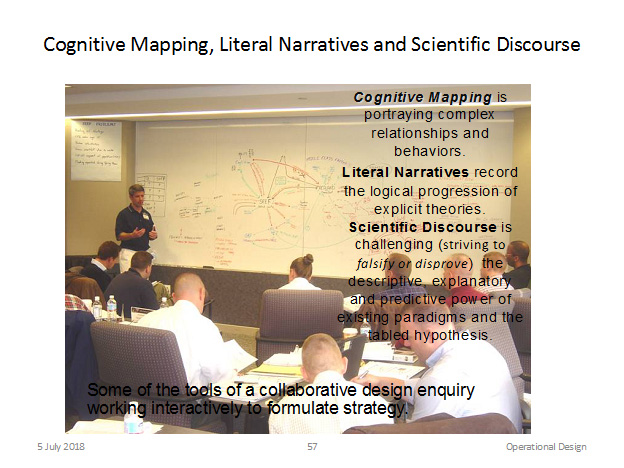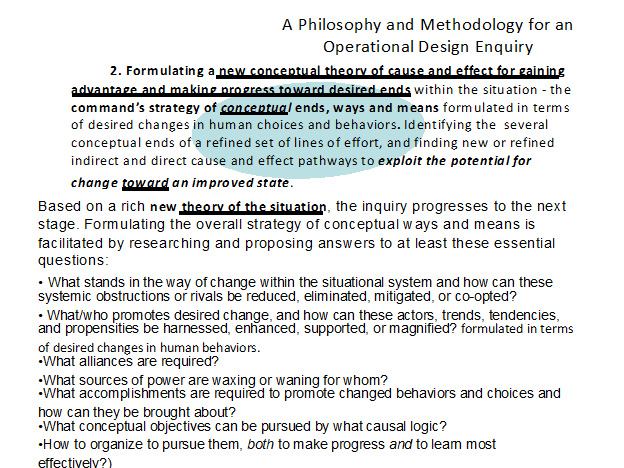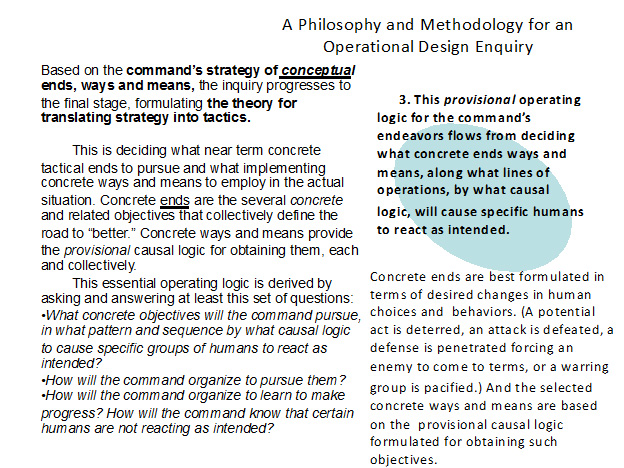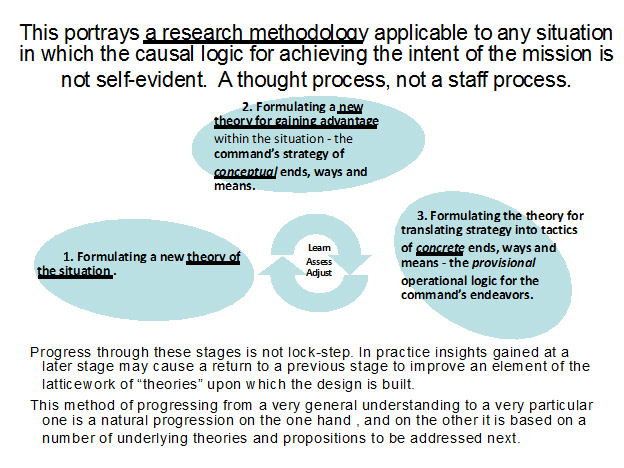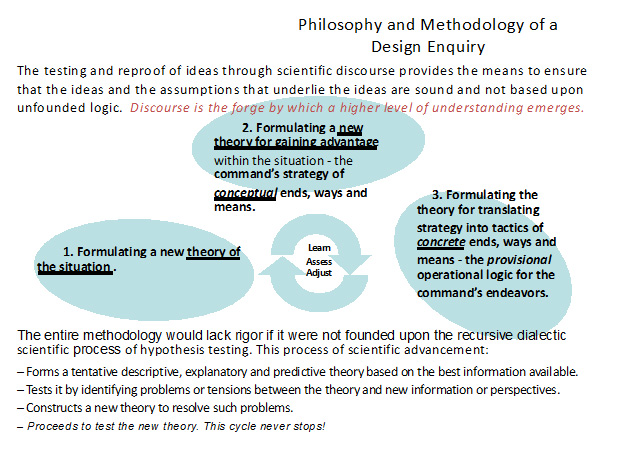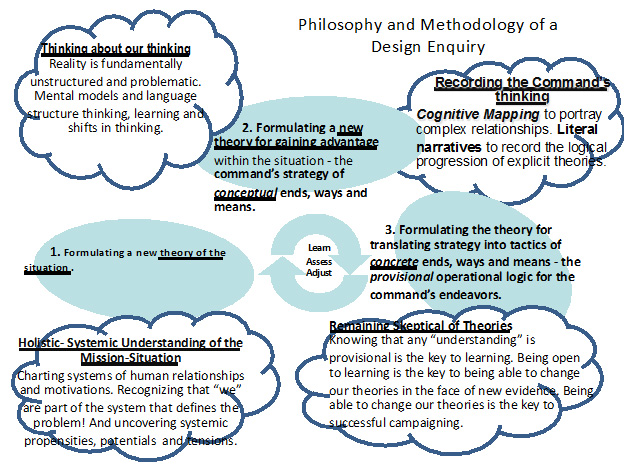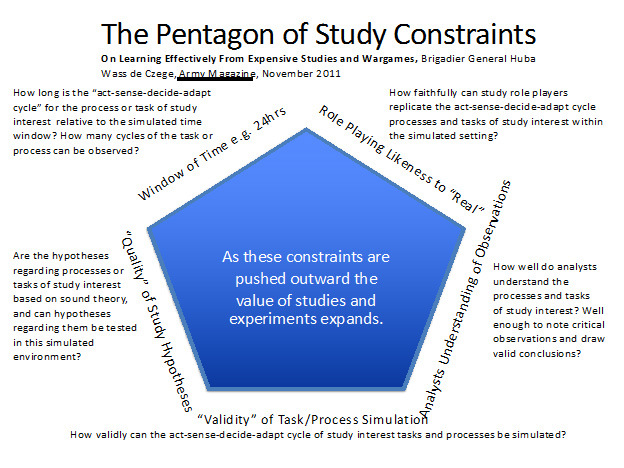Notes on The Logic of Command and Campaigning: The Art of Continually Making Two Kinds of Choices in Harmony While Learning and Adapting
Huba Wass de Czege
Read-ahead notes for a 19 July 2018 seminar with the “senior class” at The School of Advanced Military Studies, Command and General Staff College, Ft. Leavenworth, Kansas.
Contents
- The Roots of Western “Campaigning” Command Logic
- A Review of Current Operational Art Doctrine
- The Alternative in Brief
- The Theory of Theory Building: And why it should be an essential element of the Military Art and Science.
- Military Power in Dynamic and Interactive Human Complexity.
- On the Distinct Logics of Tactics and Strategy and their Relationship.
- Why “campaigning” is a matter of managing shorter Tactical Decision Cycles within longer Strategic Decision Cycles and how to do it.
- How a Collaborative Operational Design Inquiry provides a disciplined mechanism for repeatedly challenging the collective mental constructs learned from experience, previous education or doctrine, and how to do it effectively.
- How Operational Artists Collaborate Among The Echelons of a “Campaigning” Organization and learn from the learning of their superiors, peers and subordinates.
- Traditional approaches to operational art and campaign planning must be improved in several respects.
The Roots of Western “Campaigning” Command Logic
- The fundamental purpose of military strategy and tactics has always been to transform the available military force potential into the military power to cause relevant groups of humans to react as intended.
- Since the days of the Greeks (read Thucydides), organizations involved in complex human endeavors (campaigns) have differentiated the realm of “strategy” from the realm of “tactics.” They are both about achieving ends by ways and means. So what’s the difference.
- “Strategy” is derived from the Greek Strategos - the head of the fighting force who designs the grand scheme for the campaign, makes and keeps alliances, maneuvers the force to gain advantage before battle, decides when and where to fight or withdraw, and considers such other complexities as the weather, the terrain, the enemy, his allies, and the interests of “neutrals.”
- “Tactics” is derived from the Greek Taktikos – the subordinate leaders of the force who implement the designs of the Strategos and deal with concrete realities before, during, and after battle.
- As we AirLand Battle authors advanced in our thinking from the Active Defense of 1976 and its emphasis on engagements and battles to the conduct of major operations and campaigns by 1982, I realized the limitations of our linear planning logic. We can plan only as far as our forecasts prove likely. Beyond that we employ the logic of campaigning generals. We scout ahead, make educated guesses, test them to failure, revise them, scout some more and so on.
- In 1982 we introduced an “operational level of war” between Strategy and Tactics. This was to denote the realm and art of generalship and campaigning. The object at this level was to design campaigns that translate higher strategy into subordinate level tactics. The wisdoms of generalship we introduced into doctrine at that time were mostly Jominian campaigning logic laced with fitting bits of Clausewitz applicable to battles, major operations and campaigns. Thus (to help educate our guesses) we were drawn back to our mostly Jominian roots.
- The major flaw in Jominian logic is that it encourages thinking of campaign design as the application of principles and paradigms, and of warfare as a domain apart from politics. Jomini distilled Napoleon’s artful conceptions (of conceptual ends, ways and means) into elements and principles. That reductionism persists in our doctrine.
- In late 1980, when General William Richardson, the Combined Arms Center Commander at Ft Leavenworth, suggested that I look into what the Russians called “operational art” I was eager to learn about it. In my reading about the decision-making of World War II generals, such as George Patton, Erwin Rommel, Bernard Montgomery, William Slim, Eric von Manstein, Herman Balck, and others, I could see that they could plan (reason backward from a desired end) only so far into the future as their forecasts about the situation proved reliable. The situations they faced changed constantly as they advanced in their endeavors.
- In 1983, when I started the School of Advanced Military Studies (SAMS), I meant to teach this art, so our generals would have proper staff help. Our vehicle was a course in campaign studies, featuring some of the campaigns I had studied recently. With the help of the faculty, we wrote about this art in the 1986 edition of FM-100-5 Operations, as we then understood it. In Chapter 2 , we related the hierarchy of war, campaign, major operation, battle, and engagement to strategy, operational art, and tactics. We thus confirmed the primacy of policy and strategy over the application of principles at operational and tactical levels, and expanded the discussion of campaigns and major operations throughout the book. We also devoted an annex to “Elements of Operational Design.”
- The task of elaborating wisdoms on the vital relationship between political intercourse and war-fighting was assigned to the US Army War College authors of FM 100- 1 The Army.
- Unfortunately, when we humans learn, we look at everything new through the prism of our previous learning. Prior to the American Civil War, the translated writings of Jomini were the only works on military strategy that were taught at the United States Military Academy at West Point. The regular army officers who became the general officers on both sides in the Civil War began following Jominian principles. I translated “operational art” as the “art of generalship.” This is because I learned what “generalship” I knew from two sources, the recent research reading I just described, and my military history education at West Point – which was about how America’s famous generals had fought the nation’s wars from the Revolution through recent times. And, understandably, the interpretation of generalship in these historical campaigns was heavily laced with the 19th century thinking of Henri Jomini – who reduced the mysteries of generalship to the application of principles and practices to “the arrangement of tactical actions in time, space, and purpose throughout an extended operation.” This became our early working definition of operational art.
- While this 1986 version of Jominian logic worked so well against Saddam Hussein’s armed forces in 1991, it didn’t work in the 2003 invasion of his country. That war, anticipated to be short – a few weeks long, maybe several months at most -- became the “long war.”
- During the lengthy period of the Cold War, the structured logic of the “campaigns” that would be fought, if war came, was locked into the plans at NATO (down to below division level) by explicit and implicit “design” decisions taken at the beginning of the period and at the highest levels. Thus these early approaches to operational art and campaign planning do not take the inherent complexity or dynamism of most mission situations sufficiently into account, and they apply a linear planning logic to situations when such logic does not apply—reasoning from ends to ways to means. Nor does earlier doctrine anticipate the need for a disciplined mechanism for repeatedly challenging the collective mental constructs learned from experience, previous education or doctrine.
Review of Current Operational Art Doctrine
- The ten page Chapter 2: Operational Art of Army Reference Publication 3.0 Operations, explains how a commander “cognitively links actions to strategic objectives” by means of an Army Design Methodology, during the course of which, he and his staff apply:
- 12 Principles of War (Objective, Offensive, Mass, Maneuver, Economy of Force, Unity of Command, Security, Surprise, Simplicity, Restraint, Perseverance, and Legitimacy),
- And 12 Elements of Operational art (End State and Conditions, Center of Gravity, Decisive Points, Lines of Operations and Lines of Effort, Operational Reach, Basing, Tempo, Phasing and Transitions, Culminations, Risk, Defeat and Stability Mechanisms) to formulate the extended operation’s “operational approach.”
- Army Doctrine Publication No. 3-0 (ADP 3.0) United Land Operations, is the governing executive summary of the previously mentioned ten pages of text. It extols the importance of operational art, granting it a separate chapter, without the benefit of much new wisdom about how to practice it. I have reproduced below all five paragraphs (18 – 22) of that chapter and annotated my comments as indicated by my initials (HWDC).
- Para 18. Operational art is the pursuit of strategic objectives, in whole or in part, through the arrangement of tactical actions in time, space, and purpose. Hypothetically, military forces might accomplish a strategic objective through a single tactical action, eliminating the need for operational art. In reality, the scale of most modern conflicts and the ability of enemy forces to retain their operational capacity—even in the face of significant tactical defeats—make this an exceptionally rare event. Creating the military conditions necessary for the termination of conflict on favorable terms almost always requires many tactical actions. The effective arrangement of military conditions in time, space, and purpose is the task of operational art.
- HWDC. The first sentence is verbatim the same as in the final draft of the 1986 version of FM 100-5, Operations the day I handed it over to Colonel Richard H. Sinnreich, my successor, and left Ft Leavenworth for brigade command. I thought the term “operational art” was synonymous with “sound generalship,” and with the art of “campaigning.” Thus, while the above paragraph tells us what the task of operational art is -- “the arrangement of tactical actions in time, space, and purpose” – the doctrine is spare on guiding theory. This is why, as the first director of the School of Advanced Military Science (SAMS), I thought we had created SAMS to advance and teach that branch of the military art. I thought generals needed staff that is schooled in how generals should think about campaigning.
- Para. 19. Operational art is not associated with a specific echelon or formation, nor is it exclusive to theater and joint force commanders. Instead, it applies to any formation that must effectively arrange multiple, tactical actions in time, space, and purpose to achieve a strategic objective, in whole or in part. In an environment of large scale combat operations, a division might be given a series of missions, such as “seize this piece of terrain” or “destroy this enemy formation.” Each mission requires only a single tactical action, and the commander employs tactics to accomplish each. When conducting stability tasks, conversely, the same division might be given responsibility for an area of operations for an extended period, tasked to create a “safe and secure environment.” This mission requires the commander to sequence a series of tactical actions over time and space, and it requires the application of operational art.
- HWDC. I mostly agree with the first sentence. The business of “arranging tactical actions in time, space, and purpose” is not exclusive to generalship. We had abandoned the 1982 manual’s innovation: the existence of an operational level of war. That idea has not died, as we intended, but still crops up in professional and academic discussions as a shorthand for the collective levels of command commanded by generals and admirals. But from my command experience in Vietnam, I realized that even captains had need to think like generals do when they are given difficult and extended missions of great complexity, not just of the mission environment, but also of who and what consisted of the opposition, the team mates “helping” me, and the people whom I was trying to win to my side. The last part of the sentence bothers me as well: “to achieve a strategic objective, in whole or in part.” If strategic objective means the purpose of higher authorities in the chain of command, why would any subordinate element of the command not be engaged in achieving “a strategic objective, in whole or in part?” Also this, the business of “arranging tactical actions in time, space, and purpose” is some times done in a plan by backward planning from a concrete objective. Planning assumes stability among the factors that matter. When that assumption is not reasonable, you can only make an assumption of what logic will apply. That kind of reasoning is best called design. Operational art is using both modes of thought appropriately. (More explanation later.) The rest of this paragraph is unnecessary nonsense. The discussion assumes naively that some missions a division may be assigned will be so devoid of complexities (e..g unpredictable team mates, unpredictable enemies, unpredictable and stressed locals, refugees, and partisans) that the skills and mind set of operational art are not necessary? It is best to assume, as we did about the kind of fighting Cold War era divisions would have had to do in case of “hot” war. The typical latter Cold War division commander’s mission situation would be in constant flux: as they fought enemies to gain objectives; teamed with allies whom they did not command; against enemies that would surprise them; among people who are bystanders; fending off enemy special operations forces; and guarding against criminal gangs looting supplies.
- 20. The 12 principles of joint operations represent important factors that affect the conduct of operations across the levels of warfare. The 12 principles are objective, offensive, mass, maneuver, economy of force, unity of command, security, surprise, simplicity, restraint, perseverance, and legitimacy. Rather than a checklist, the principles are considerations. While commanders consider the principles in all operations, they do not apply in the same way to every situation. Nor do all principles apply to all situations. Rather, these principles summarize characteristics of successful operations.
- HWDC. I do not deny that such principles are sound guidance, whatever the mission, whatever the echelon of command. I think these belong in “Military Art 101,” not operational art.
- Para. 21.In applying operational art, Army commanders and their staffs use intellectual tools to help them understand an operational environment as well as visualize and describe their approach for conducting an operation. Collectively, this set of tools is known as the elements of operational art. The 10 elements of operational art are end state and conditions, center of gravity, decisive points, lines of operations and lines of effort, basing, tempo, phasing and transitions, culmination, operational reach, and risk. These elements help commanders understand, visualize, and describe the integration and synchronization of the elements of combat power as well as their commander’s intent and guidance.
- HWDC. This paragraph tells us that commanders and staff use “intellectual tools” to perform the magic of operational art. My minor point is: so, were the principles of para 20 something other than “intellectual tools?” And the major point is this. Just how do these tools help if operational art is the fruitful arrangement of tactical actions in time, space, and purpose, in an operation over an extended period of time, during which the situation is constantly evolving (not only in stability ops, but also in offensive or defensive campaigns fighting the armed forces of major powers in any imaginable context) due to actors and factors not under the command’s control? The authors have posed two cognitive tasks, 1) understanding an operational environment, 2) as well as visualizing and describing their approach for conducting an operation. I would put cognitive tasks a different way. The operational artist faces two major cognitive challenges, each in two parts. He first needs a theory that makes sense of a very complex mission situation he has been assigned to change for the better. He needs a theory within the former theory of what constitutes “better” in the eyes of higher authorities. This really is “framing the problem.” Then he needs to “frame a solution.” To do that he first needs a “theory of victory,” a conceptual theory of ends, ways and means, upon which to base an operating logic of concrete tactical actions sequenced in a series or parrallel along multiple lines of operations. This is more than “understanding an operational environment” and then “visualizing and describing their approach for conducting an operation.” If this is all that is intended for operational art to be, then what is offered is woefully inadequate to the first, a task of creating relevant knowledge, and overly much like tinker toy parts for the second, a task of creating uniquely designed ways and means.
- Para. 22. Operational art is how commanders balance risk and opportunity to create and maintain the conditions necessary to seize, retain, and exploit the initiative and gain a position of relative advantage while linking tactical actions to reach a strategic objective. It requires commanders who understand their operational environment, the strategic objectives, and the capabilities of all elements of their force. These commanders continually seek to expand and refine their understanding and are not bound by preconceived notions of solutions.
- HWDC. This is all sound, timeless and generic advice. But the gaping hole in this doctrine is how to learn how to apply this advice to a particular mission situation. How does the commander learn about his particular situation? What is risk and what is opportunity? What is a “position of relative advantage?” How can it be seized, retained, and exploited? Who are his allies, who are his enemies, and how is this changing? How are his allies, enemies and “neutrals” reacting to his actions and messages?
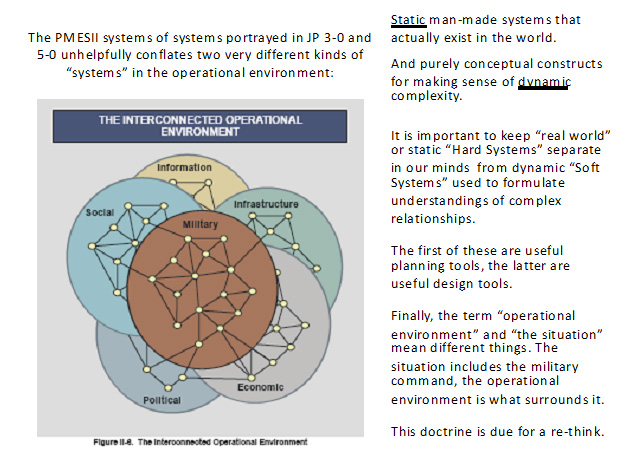
To say that the main purpose of Army Design Methodology is to “cognitively link actions to strategic objectives,” and that “design” is “a methodology for applying critical and creative thinking to understand, visualize, and describe complex, ill-structured problems and develop approaches to solve them” misses the main point of design.
The Alternative in Brief
In a Nutshell
- Operational Art is better conceived as the art of continually making two kinds of choices in harmony while learning and adapting.
- Historical experience shows that making headway toward a better state in any extended campaign or military operation requires periodically making both conceptual choices of how to understand the always opaque and perpetually changing objective situation and practical choices of how to take concrete action to improve it.
- The first of these choices pertains to conceptual strategy and the second to concrete tactics. Thus operational art is essentially a matter of managing shorter tactical decision cycles within longer strategic decision cycles and of mediating between strategic design and tactical planning.
- Operational art theory facilitates thinking in terms of large and complex competing fighting systems within even larger complex systems. It also facilitates more rapid and effective learning at both the conceptual and practical levels, and thus adapting strategies and tactics (including their ends, ways and means) more swiftly. Campaigns would more likely succeed, shorten, and economize effort.
Operational Art is a Generally Useful Kind of Reasoning
- Operational art is not a kind of reasoning that pertains only to “flag rank” commands at “operational echelons.” It is the kind of reasoning that pertains to any purposeful and extended endeavor set in dynamic and interactive human complexity.
- It is thinking and acting like an explorer before the days of Google Earth, The Weather Channel, and Global Positioning Systems. While exploring uncharted territory does rely on the linear logic of planning for some aspects of the exploration (the everyday tactics of doing familiar things sensibly), formulating the governing logic (or conceptual strategy) of the expedition is a kind of reasoning that is different. While tactical and strategic thinking are fundamentally different, both kinds of thinking must take place in the explorer’s brain, but in separate compartments.
- See Thinking and Acting Like an Early Explorer (Operational Art is Not a Level of War) by Huba Wass de Czege, Brigadier General US Army, Retired; Small Wars Journal April 2011.
- In fact it is the kind of reasoning that would help humans every day, especially when they think about raising a family, building a business, or making progress in a professional career.
Operational Art Applies to “Campaigning”
- A “campaign” is normally the term for military operations at the theater level of command. However, “campaigning” is the most appropriate term for any extended mission set in dynamic and interactive human complexity even at much lower levels of command. And thus “campaigning” occurs at multiple levels simultaneously in many situations today.
- Thus unlike the ancient Greeks, modern commanders in multi-echeloned campaigning” commands must continually make both Strategos-like and Taktikos-like choices and decisions at multiple echelons simultaneously. This means that commanders at multiple echelons must now make the conceptual choices of how to understand the always opaque objective situation with one part of their brains, while they also make the practical choices of how to take concrete action to improve it with the other. And, to do this well, these brain parts must cooperate.
- See “Operational Art: Making Two Kinds of Choices in Harmony While Learning and Adapting” by Huba Wass de Czege, Brigadier General US Army, Retired, Army September 2011
The Realm of “Operational Art” Reasoning
- Now, as in the past, commanders at multiple echelons will encounter inherently complex and dynamic mission situations in which they must cause enemies, allies, and “neutrals” to react as intended.
- As in the past, we will base future interventions on theories of the situation that are, at best, under-informed and always behind the times, basing our action on ends, ways and means derived from old thinking.
- Thus, commanders at almost every echelon in any “campaigning” organization must repeatedly challenge collective mental constructs (paradigms, theories, and methodologies), learned from experience, previous education or doctrine, that comprise their strategic designs.
- They must understand the distinct logics of tactics and strategy and their powerful relationship. Strategy is a governing conceptual scheme for making mission progress. Tactics is a concrete scheme for executing the several sequential or parallel and concrete objectives that count as progress within the governing strategy.
- They must translate their strategic designs into Tactical plans, applying design logic to their strategies and planning logic to their tactical plans, manage shorter tactical decision cycles within longer strategic decision cycles, learn from the learning of their superiors, peers and subordinates, and continually adapt their thinking while they adapt their doing.
The Distinct Logic of Strategic Design
- Strategy is a governing conceptual scheme for making mission progress in a situation of dynamic and interactive human complexity. Strategic wisdom is visionary and entrepreneurial. It is plotting the way ahead among great uncertainties, mitigating exposure to possible danger and exploiting unforeseen opportunity. The strategist expands existing knowledge and reasons forward toward an end based on educated guesses.
- Most importantly, strategy is a prediction based on a two-part theory. The theory of the situation, and the theory that mission ends can be achieved by the conceptual ways and means of the strategy. Sound theory building derives from sound scientific reasoning about how force potential, in a particular situation, can be transformed into power to cause relevant humans to act as intended. It also requires a disciplined mechanism (a collaborative operational design inquiry) for repeatedly challenging the collective mental constructs learned from experience, previous education or doctrine.
- Because strategies are dependent on predictions and educated guessing, sound strategic design is an iterative process dependent on sensing when predictions and guesses are no longer valid. Thus “campaigning” is a matter of effectively managing shorter Tactical Decision Cycles within longer Strategic Decision Cycles.
The Distinct, and Familiar, Logic of Tactical Planning
- Tactics is a concrete scheme for executing the several sequential or parallel and concrete objectives that count as progress within the governing strategy.
- It is also the art of getting concrete results under difficult circumstances. Tactics demands personal leadership, disciplined management, and improvisational optimization.
- The tactician exploits existing knowledge, reasons backward from an end based on a tested governing logic of systemic cause and effect.
- The Tactician commits to the logic of the causal theory and forces desired concrete outcomes.
The Theory of Theory Building: And Why it Should be an Essential Element of the Military Art and Science
- Theories are “formulated” rather than “discovered.”
- Theories are very educated guesses about reality. Some are useful and some are not, but none of them are true to reality. The useful ones provide a “good enough” approximation.
- Useful and viable theories describe, explain, predict well enough within the realm and endeavor for which they have been formulated.
- (Read up on Thomas Kuhn’s theory about scientific theories.)
- The work horse of science is not the test tube. Nor is it a competition of assertions and beliefs, in which compromise or political clout decide the formulation of theories.
- How do educated guesses become useful and viable theories?
- Educated guesses called hypotheses become viable theories only when they have resisted rigorous attempts at falsification.
- When either a hypothesis, or a long-reigning theory, is falsified, the scientific community constructs a new hypothesis to resolve the difference between old and new knowledge, and the cycle of testing begins anew.
- Thus even at best, theories are very educated guesses that may prove useful only within limited circumstances and for limited spans of time. Good science is ever-skeptical. Good military science is as well.
- While part of scientific work is to explore the implications of reigning theories and expand their utility, the work of “pure science” is different. It is to test the limits of reigning theories.
- Thus, the real work fundamental to science is a perpetual recursive dialectic process in the care of perpetual skeptics that never ends.
Recursive Steps of the Scientific Method
- Observe a phenomena.
- Describe it.
- Develop a hypothesis to explain it.
- Formulate a prediction from the hypothesis.
- Test the prediction.
How Do We Adapt This to Expand Relevant Military Knowledge?
Success in difficult military missions … involves rigorously applying the logic of all four sequential and recursive steps of the fundamental problem-solving process of science. See Huba Wass de Czege in “Difficult Missions,” Military Review, May 2012
- Structuring or “framing” the problem, that is, making conceptual sense of a troubling situation. (Given the mission-situation, what is the condition that needs to be changed?)
- Developing a conceptual strategy (a theory for making forward progress) based on step 1. This may be as simple as taking advantage of the tendencies that are already making it “better” and blocking or mitigating those making it “worse.”
- Formulating and executing the tactics of concrete ends, ways and means .
- Deciding what near term concrete tactical ends to pursue and what implementing concrete ways and means to employ in the actual situation.
- Acting to produce concrete outcomes that the strategy predicts will transform the situation into one more desirable. (Transforming the situation implies affecting certain human choices and behaviors.)
- Learning the appropriate thing from execution attempts to adapt both the tactics of concrete ends, ways, and means, and the governing strategy of conceptual ends ways and means.
Time invested in the first two conceptual steps will be amply repaid. Unfortunately, this reasonable advice is more often not heeded in practice.
Military Power in Dynamic and Interactive Human Complexity
- Any extended military endeavor involves many thinking and interacting human beings who are constantly evolving relationships, ideas, movements and needs.
- Any application of military force is justifiable only if it has a high probability of causing humans to react as intended. Military force becomes military power only when it does.
- These propositions are central to any useful logic of command, operational art, strategy, and tactics.
“Fix Ramadi, but don’t destroy it. Don’t do a Fallujah.” Mission of 1st Brigade, 1st Armored Division, June 2006. Col. Sean MacFarland.
Or
“Disrupt, dismantle, and eventually defeat al Qaida”
-
- Given such missions, are we better at “doing things right,” than “doing the right thing?” (Do we default to “off-the-shelf” strategies and familiar tactics rather than tailor-made strategies and adapted tactics suited to the unique situation?)
- “The right thing” (a well-suited strategy) in many situations is not self-evident!!!
When the logical structure of a mission is not self-evident it requires an imposed logic.
When faced with a complex situation, the evidence suggests how we think, view the world, and frame problems constrains us. Do we challenge our mental constructs or are we anchored to preconceived ways of thinking?
- People constantly make decisions and adjust their behaviors based on their shifting intentions and evolving beliefs, rather than on fixed laws of nature. And individuals and groups often carry multiple identities according to how they understand the situation with which they are dealing. Furthermore, new science challenges the rational model of human judgment and decision making.
- Whatever specific end is proclaimed at the start may not be reached because whatever specific path is charted to that end may become a dead end as the situation evolves.
- This means that any theory about how to progress toward any vision of “better” will be wrong entirely or at least partially so at the outset—and, because of constant and unpredictable changes in the situation, it will get less productive over time.
- Because of this situational dynamism such theories require periodic revision.
- Is it time to question a foundational paradigm: the destructive military instrument operates on the state of mind of leaders, followers and supporters, causing them to give up fighting and accept the will of their enemy?
- It is one thing to modify or disrupt man-made systems; it is quite another thing to modify or disrupt the intentions of actual men.
- Because we can only ever guess what strangers are thinking and what factors matter to them, we cannot know with certainty whether attacks on “high value” targets will cause submission, or how long it will take before decisions to submit are taken, or what form these decisions will take.
- Wise strategists think of power, to whatever purpose it is put, in relative rather than absolute terms.
- All the sides in a conflict try to cause the humans on the other side to react as they intend.
- The outcome of the conflict is determined by a relative superiority of power specific to the case at the essential points of confrontation.
- Thus relative military power is not determined by mere comparisons of the military potential inherent in the capabilities each side has at hand.
- Although the amount and quality of military capabilities and resources available to each adversary are important, relative power is determined in the main by how these capabilities and resources affect the humans on each side of the conflict when they are brought to bear.
- The conversion of potential to power is largely a function of intangible and non-quantifiable factors.
- Superior knowledge of war and sound decision-making, better training, higher motivation, greater firmness of purpose, and above all the ability to learn and adapt more rapidly while operating, have caused armed forces and their leaders to succeed, even against numerical odds.
- The great captains of history -- Alexander, Hannibal, Caesar, Gustavus Adolphus, Fredrick, Napoleon, Mao, Ho Chi Minh and others -- had the ability to upset simple force ratios.
- The power to decide battle is also relative and a matter of transforming given combat forces into the power to influence the decisions and options of adversaries. It does not matter what service or combination of services comprise combat forces, nor whether battles are fought at sea, in the air, in space, or on land. The logic is everywhere the same.
- Prior to battle there exists only capability. Leaders and the forces of their environment, to include the actions of the enemy, transform this capability into the power to contest the outcome. Superior leaders and units can generate enough power on the battlefield to prevail against forces vastly superior by any objective criteria. Combat potential transforms into superior power at the decisive point and time to win the battle, by means of the appropriate combination of four factors: maneuver, firepower, protection, and skilled leadership.
- Instead of classifying powers according to their “domains,” strategists would do better to conceive of military power according to its functions.
- Military power can deter attack, defend against attack when deterrence fails, attack in order to impose and enforce a new and better peace where an intolerable one exists, and pacify an intolerably violent situation.
- Strategists through the ages have brought military force to bear for these broad categories of purpose, and so will strategists today.
- Strategists have not always been successful, however, even when subject to overwhelming military force, humans do not always react as intended.
- This is so because force is not power, and because force potential is transformed by a logic specific to each of these broad categories of strategic purpose.
- (see The Military Power to Deter, Defend, Enforce, And Pacify by Huba Wass de Czege in American Grand Strategy and the Future of US Land Power ssi.armywarcollege.edu )
On the Distinct Logics of Tactics and Strategy and Their Relationship
Summarizing (Again) the Chief Differences
- Strategy is a governing conceptual scheme for making progress. It is also the art of plotting the way ahead among great uncertainties. The strategist expands existing knowledge and reasons forward toward an end based on educated guesses about the dynamics of the mission situation. Strategic wisdom is visionary and entrepreneurial. It mitigates exposure to possible danger and boldly exploits unforeseen opportunity. Most importantly, strategy is a prediction based on a two-part theory. The theory of the situation, and the theory that mission ends can be achieved by the ways and means of the strategy.
- Tactics is a concrete scheme for executing the several sequential or parallel and concrete objectives that count as progress within the governing strategy. It is also the art of getting concrete results under difficult circumstances. Tactics demands personal leadership, disciplined management, and improvisational optimization.
- The tactician exploits existing knowledge, reasons backward from an end based on a tested and fixed logic of systemic cause and effect. Therefore tactics is also a prediction based on a theory. The Tactician commits to the logic of the causal theory and forces desired concrete outcomes.
Strategic Logic
- Strategy is a governing conceptual scheme for making progress in “open system” mission situations, ones set in dynamic and interactive human complexity.
- Strategies are “designed,” not planned, because planning logic does not apply. Designs are created by reasoning forward from a rich understanding of the past and present toward the future. They formulate a well-researched “closed system” theory of the situation that has prompted the mission. And, and from this, a theory for causing intended changes in the choices and behaviors of enemies, allies, and “neutrals.”
- Strategies require periodic revision as a matter of course. The viability of strategies inherently expires as key circumstances of the situation change. Human interactions constantly evolve. New facts come to light. Circumstances that earlier appeared inconsequential become critical. And key predictions missed the mark.
Strategic Logic and Forecasts
- Strategic design has always included forecasts of what the relevant “others” in a given circumstance will do in response to optional actions and changing circumstances.
- Sound forecasting depends on research, probabilistic judgments, and modesty.
- Research can uncover relationships, tendencies, habits, and patterns of behavior.
- Probabilistic judgments systematically estimate the likelihood of future occurrences based on available information. Thomas Bayes’s Theorem (from the first part of the 18th century) can be very helpful because it pertains to epistemological uncertainty – the limits of our knowledge. See pages 243 to 261 Nate Silver, “The Signal And The Noise”). No forecasting methods are perfect, but some can be a path to less “wrongness.”
- Modest predictions of the near future are more likely to be accurate than bold ones for the far future, because current information will be more relevant in an application of Bayes Theorem.
Tactical Logic
- Tactics has always been the art of practical improvisation within given circumstances and getting concrete results under difficult circumstances.
- In a modern sense, tactics are the concrete schemes for executing the several sequential or parallel and concrete objectives that count as progress within a governing strategy.
- Tactics are “planned.” Plans are created by reasoning linearly backwards from ends to ways and means, within a “closed” system logic provided to planners by the strategy.
- The governing strategic logic provides a specific understanding of mission circumstances, and also assumptions of logic that govern the attainment of concrete mission objectives.
- Additionally, planners will always have to account for uncertainties within the closed system of the strategic logic. For instance, they will never have all the facts they require, and will have to assume them. And they will have to account for the knowable options of the actors within the strategic framework.
Summarizing the Chief Differences Between Strategic and Tactical Adaptation
- The strategy adapts to changes in the command’s conceptual understanding of the mission situation. Strategic adaptation is as much reshaping and re-sizing the box as it is inventing ways to gain competitive advantage within the new box.
- And tactics adapt to the changing concrete circumstances pertaining to accomplishing prescribed concrete objectives. Tactical adaptation is getting better at optimizing within the conceptual box you are in!
Why “Campaigning” and Operational Art is a Matter of Managing Shorter Tactical Decision Cycles Within Longer Strategic Decision Cycles
Because a “campaign” is any extended military endeavor involving many thinking and interacting human beings in competition, in alliance, or neither, operational art (or campaigning) is really a matter of managing shorter Tactical Decision Cycles within longer Strategic Decision Cycles.
- Iteratively acting within the logic of any given strategic problem frame is called the tactical decision cycle in current doctrine, or the Boyd OODA loop. (This is also acting within the possibilities and logic of a current theory.)
- Because we should expect strategies to expire as circumstances change, and thus cause tactics to become irrelevant to strategic progress, it is useful to have in mind a decision cycle for periodic updates of strategy.
- These cycles differ in important ways. But both must be managed and harmonized in the same headquarters and in the commander’s brain.
Characteristics of Tactical Learning and Decision Cycles
- Tactical learning is well served by the rapid turning of the Boyd OODA loop, and what we have called the “decision cycle” in our doctrine since the 1980’s:
- Orient on the enemy, to
- Observe and note relevant phenomena, to
- Decide on necessary adaptations, and to
- Act in newly relevant ways to gain advantage.
- Tactical learning is learning within the realm of “doing” rather than “thinking.” It improves execution performance by concrete ways and means toward concrete objectives. Trained and experienced tacticians decide the best way to exploit existing knowledge to optimize their actions in the present mission circumstances. They reason backwards from a concrete end, based on a tested and fixed logic of systemic cause and effect.
- Established doctrine has shaped the current intelligence system mostly to meet the information demands of this cycle and its objective metrics.
Characteristics of Strategic Learning and Decision Cycles
- Today the strategic kind of learning and adapting, that of our thinking, occurs episodically. Something causes the command to perceive the situation differently. It could be a sudden and unexpected crisis, or the accumulation of clues of failure to a threshold that cannot be ignored. It could also be a new directive from a superior level of the hierarchy.
- As a result, commanders learn far too slowly that what they initially thought they knew was actually wrong or no longer relevant. Registering success against concrete objectives is too reassuring. And the inevitable first clues to the failure of the strategic rationale needs to swim upstream against the current of strongly held preconceived beliefs. Also, leaders ask the wrong questions of intelligence sources—they rarely ask, “Prove to us that our strategic thinking is wrong.”
- Instituting a separate, deliberate, and rigorous strategic decision cycle has great benefit and, when instituted, will shape new modes of learning and demand new and different information appropriate to making strategic, rather than tactical, choices.
- Mission strategies are reframed only when the command recognizes that its understanding of the situation is no longer relevant. Keeping its understanding of the situation up-dated requires a deliberate effort, one that charts progress along multiple lines of effort, and also rigorously seeks to falsify the theories underlying its strategic thinking.
- While all commanders value actions that advance their aims, entrepreneurial ones value actions as much or more that reveal new knowledge about learning how to advance further.
- Effective strategic decision cycles are initiated by two kinds of actions. Those designed to produce concrete results – usually along multiple and related lines of operations. And those designed to test responses and clarify or develop strategic understanding.
- The next step of an effective strategic learning and decision cycle is to sense what changed in the situation as a result of these actions. Did the tactical results actually advance the strategic cause? (Did the enemy, allies, and “neutrals” react as intended and predicted?) Did the actions to develop the situation provide new understanding? In what way were the command’s theories wrong about how the "mission world" works and how to “advance?” Is there un-exploited potential within the situation for a wiser strategy?
Decisions to adapt the campaign strategy and decisions to adapt modes of learning come from answering such questions.
How a Collaborative Operational Design Inquiry provides a disciplined mechanism for repeatedly challenging the collective mental constructs learned from experience, previous education or doctrine.
Learning to Do Our Forward Designing as Scientifically as We Do Our Backward Planning
- For best effect, an operational design inquiry requires the commander’s participation and is immersed in a deliberate, command level, strategic decision-making process that attends to periodic reframing.
- It is a close and critical examination of what is known about a given situation in order to create a structured logical mental conception—a latticework of tested hypotheses — so that tactical planning and tactical action can proceed on a sound footing.
- This structured logical mental conception is most usefully constructed in three layers.
- Everything rests on the prevailing theory of the situation. Renewing this requires: gaining a more informed perspective of the situation from learning and research; capturing anew the essential meaning of the situational human dynamics; and refining the broad conceptual aim of the endeavor.
- From this the design inquiry evolves a new theory for gaining advantage within the situation – an improved governing conceptual scheme for making progress. This strategy for advancing toward that broad conceptual aim emerges from identifying and clarifying the several conceptual ends of a refined set of lines of effort, and finding new or refined indirect and direct conceptual ways and means to achieve them.
- The above two theories comprise a strategy, but the command still needs a logical mental construction or theory for translating a conceptual strategy into the tactics of concrete ends, ways and means to cause specific humans to react as intended. This becomes the provisional operational logic for the command’s endeavors until the first two layers of theory are revised. This logic specifies what near term concrete tactical ends to pursue and what concrete ways and means to apply to achieve the command’s purposes.
Philosophy and Methodology of a Design Enquiry: Summing Up
- Design is simply making rational the seemingly irrational so that rational tactical planning and tactical action can proceed.
- A Design Inquiry is a focused search for a contingent logic, when none is self-evident, upon which to base a tactical plan of action, and one that exploits the best potential for change toward an improved state.
- Learning while operating drives both design reformulation and tactical adaptation.
- Strategic learning occurs most reliably when the command strives to falsify or disprove its previously derived operative logic, and then through a new design enquiry formulates a new one. This is analogous to the process for advancing scientific knowledge. This adherence to scientific method not only promotes collective critical thinking—it also builds shared understanding and useful hypotheses layer by layer.
- Design is really a disciplined way of reasoning forward, as opposed to reasoning backward, as is planning!
How Operational Artists Collaborate Among the Echelons of a “Campaigning” Organization and Learn from the Learning of their Superiors, Peers and Subordinates
- Design inquiries are most fruitful when they occur at multi-levels in campaigning organizations, and when these maintain “cross-talk” not only with other design inquiries at the same level, but with those at higher and lower levels as well.
- The product of a sound design inquiry occurring at a lower or adjacent level can be more fruitful than that of a senior headquarters.
- Whatever new theories are thus learned from others must still be rationalized against those internally derived.
- We are more accustomed to learning about our doing than about our thinking?
- This will require a different kind of conversation prompted by a different set of questions.
Traditional Approaches to Operational Art and Campaigning Must be Improved in Several Respects
- First, they do not take the inherent complexity or dynamism of most mission situations sufficiently into account, and they apply a linear planning logic to situations when such logic does not apply—reasoning from ends to ways to means. We are better at capturing complexity than dynamism.
- Second, they do not emphasize the importance of differentiating between the logic of tactics and the logic of strategy. And we do not understand the logic, language and grammar of strategy nearly as well as the logic, language, and grammar of tactics.
- Third, they do not recognize intelligent campaigning and operational art as essentially a matter of managing shorter tactical decision cycles within longer strategic decision cycles and of mediating between strategic design and tactical planning. This means learning and adapting in two realms: that of our “thinking” and that of our “doing.”
- Fourth, they do not provide a disciplined mechanism for repeatedly challenging the collective mental constructs learned from experience, previous education or doctrine. This is having a way not just to “think out of the box,” an easy task, but having a scientific way to build a more useful box for our rational thinking.
- Finally, why not use strategic design inquiries to develop the grand concepts of the US Joint establishment? Scientists have, for centuries, used a similar process to explore and harness the mysteries of the universe.
